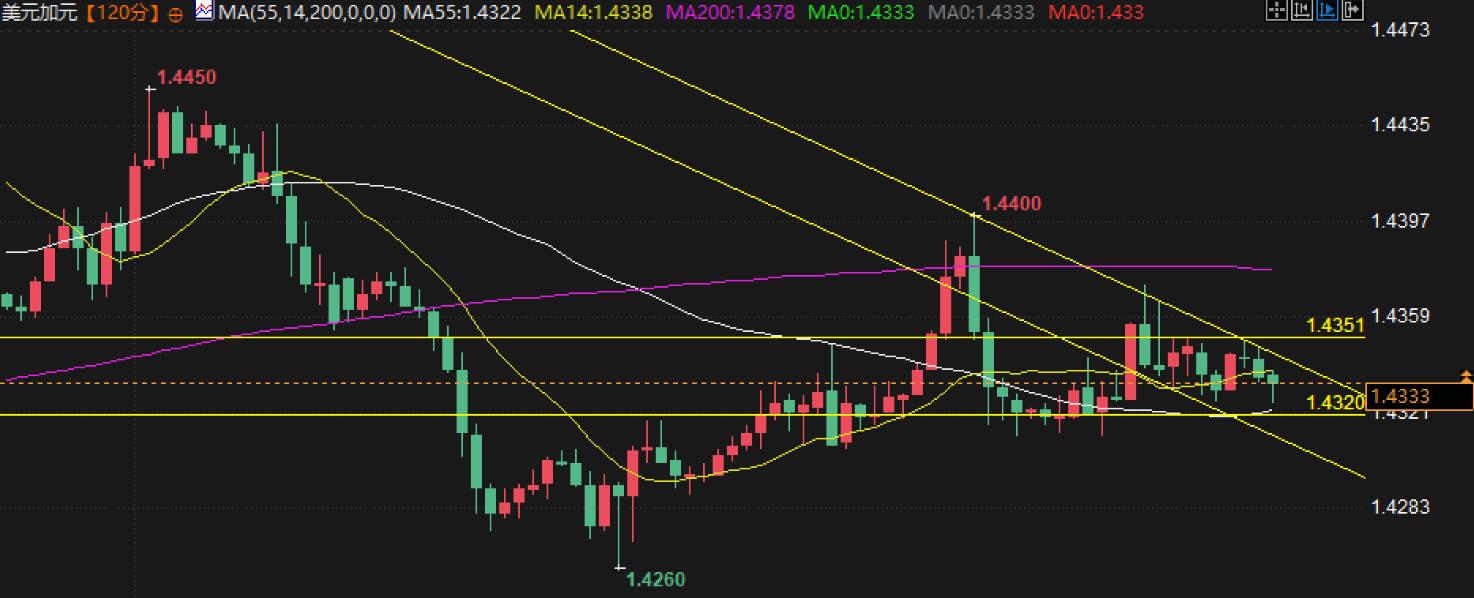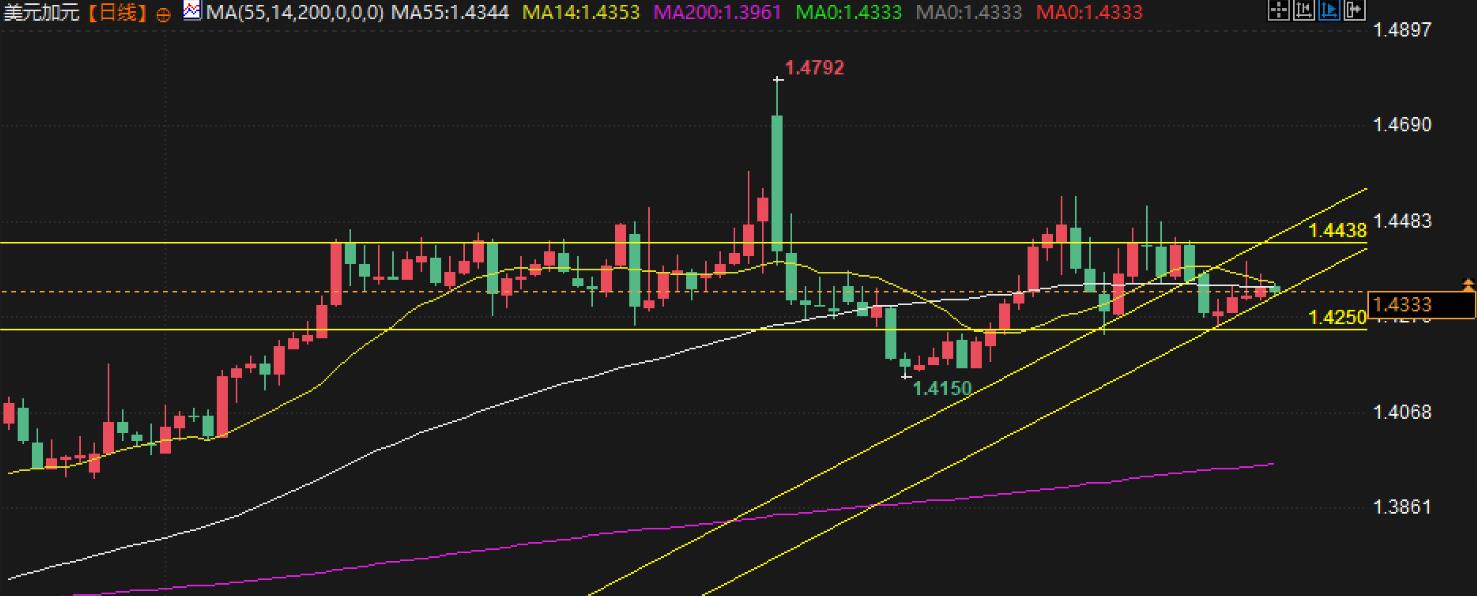Forex trading analysis: USD/CAD channel under pressure
On Monday (March 24th), the USD/CAD slightly fell during the European trading session, giving up some of the gains from last Friday, indicating a resurgence of short-term selling pressure. The market still has considerable expectations for the prospect of the Federal Reserve cutting interest rates within the year, coupled with the combined effect of weak oil prices and domestic political uncertainty in Canada, which has led to the overall consolidation of the US dollar/Canadian dollar.
Fundamental analysis
The Federal Reserve has raised its inflation expectations in its latest statement, but maintains its outlook of two 25 basis point rate cuts before the end of this year. The risk of economic slowdown caused by tariff factors still exists, and speculation in the market that the Federal Reserve may resume loose policies earlier than previously expected has once again heated up. Correspondingly, the market's demand for the US dollar has temporarily been suppressed, bringing some downward pressure to the US dollar/Canadian dollar.
Meanwhile, external sources indicate that Trump plans to implement more targeted tariff measures starting from April 2nd, and the market is watching the impact of this policy on the economic outlook. In addition to the new progress of negotiations in the Russia-Ukraine conflict, it is reported that the relevant delegations will continue to meet with the Russian side this week, and Trump and Putin also reached a consensus at the beginning of this month that "air strikes on Ukrainian energy facilities will be suspended for 30 days", which has led to a recovery of risk appetite in the equity market and further weakened the risk aversion of the US dollar.
However, Canada also faces potential uncertainty. Canadian Prime Minister Mark Carney recently announced the early general election on April 28th, hoping to seek broader support on issues such as addressing tariff measures. This political change may impact confidence in the Canadian dollar in the short term. At the same time, crude oil prices hit a three week high last Friday, but due to market concerns about a slowdown in global demand recovery, oil prices have not been able to further strengthen, weakening the commodity attribute support behind the Canadian dollar. Under the dual factors, the US dollar/Canadian dollar is currently intertwined with long and short positions, and has not yet shown a unilateral trend.
Looking ahead to this week, the market will focus on the upcoming release of the initial US PMI values and speeches by multiple Federal Reserve officials, seeking more clues about the path of monetary policy. In addition, Friday's Personal Consumption Expenditures (PCE) price index, as the inflation indicator that the Federal Reserve is most concerned about, will have a significant impact on the pace of interest rate cuts this year and will inevitably influence the subsequent direction of the US dollar/Canadian dollar.
Technical analyst interpretation:
From the 2-hour chart, the exchange rate has fallen from around the high point of 1.4400 and is currently fluctuating around 1.4330. The adhesion between short-term moving averages indicates an intensification of long short divergence. The price is being suppressed by a downward trend line extending from the high point of 1.4400, while there is a temporary low point support around 1.4260. MACD oscillates repeatedly near the zero axis, with column momentum turning red and green at times, reflecting the fluctuation of long and short forces in a short period, and the trend direction is not clear. RSI hovers around the central axis of 50, indicating a lack of significant overbought or oversold signals in the short term. If the future price can break through the range of 1.4350-14.4400 above, and there is more than 1.5 times ATR momentum to support it, it may be confirmed that short-term upward momentum will be exerted; On the contrary, if it continues to be under pressure below the downward trend line, it is necessary to be alert to the possibility of further exploration towards 1.4260.
The daily chart shows that after encountering resistance at the 1.4792 level and falling back, the overall range of the exchange rate fluctuated between 1.4169 and 1.4483. The current price is between multiple moving averages, with MA200 far around 1.3961, indicating that the long-term trend has not yet turned bullish; MA14 and MA50 are relatively dense in the area of 1.4300-1.4350, forming the current important entanglement region. The area from 1.4483 to 1.4490 above may pose strong resistance, and once the daily price level effectively breaks, further upward space can be opened up; 1.4205 and 1.4169 below are the key support ranges in the near future, and once they are breached, it may trigger a new round of downward pressure on the technical side. MACD is stuck near the zero axis, with a weak kinetic energy column and RSI fluctuating between 45-50, indicating a temporary stalemate between long and short forces. The daily structure is still in a volatile pattern, and it is necessary to closely monitor the breakthrough or loss of prices in the above key ranges to determine the medium-term direction.

Future prospects
Overall, the current USD/CAD exchange rate is facing a cross impact of multiple factors, including the prospect of interest rate cuts by the Federal Reserve, the direction of tariff policies, the domestic political situation in Canada, and the performance of oil prices, all of which will affect the pace of the exchange rate. Against the backdrop of short-term fluctuations, if market risk appetite rebounds after the introduction of tariff details, the US dollar may continue to weaken; On the contrary, if political uncertainty in Canada increases and crude oil prices are unable to recover for a long time, the exchange rate may still receive support. Attention should be paid to this week's US PMI and Friday's PCE data in the future. Once the data deviates significantly from expectations, it may trigger a new round of volatility. Overall, the short-term trend tends to fluctuate within a certain range, while the medium-term direction needs to wait for further clarification of macro news before confirming the direction.
Note: The fundamental content of this article is based on reports from Refinitiv.
Tips:This page came from Internet, which is not standing for FXCUE opinions of this website.
Statement:Contact us if the content violates the law or your rights
